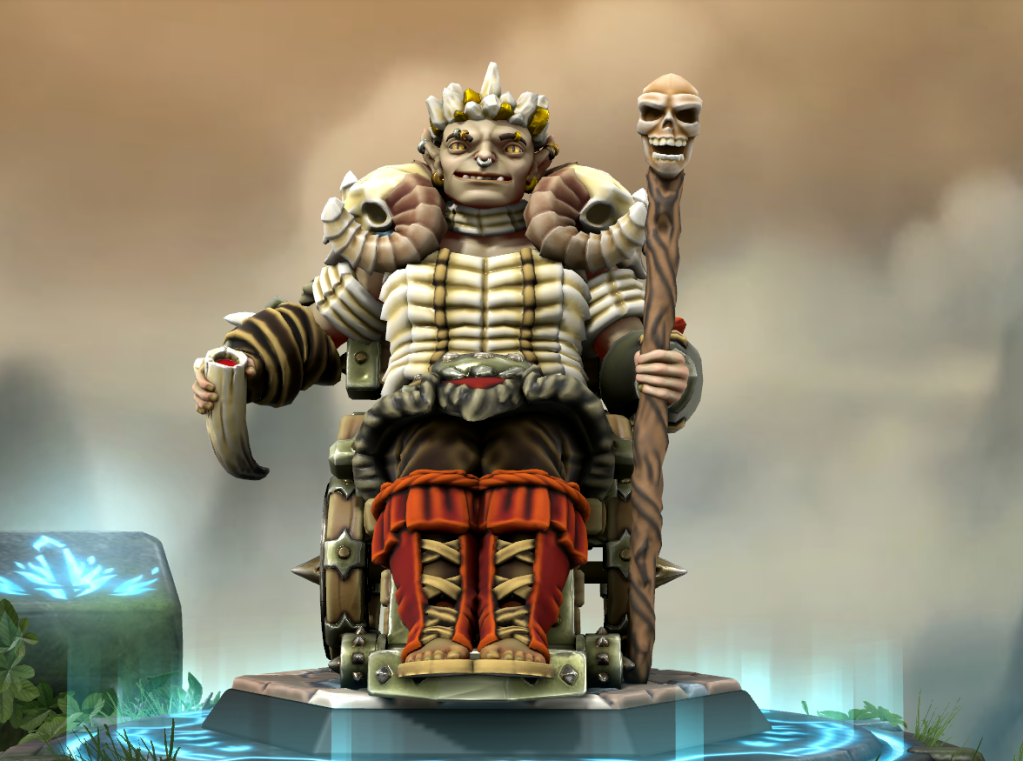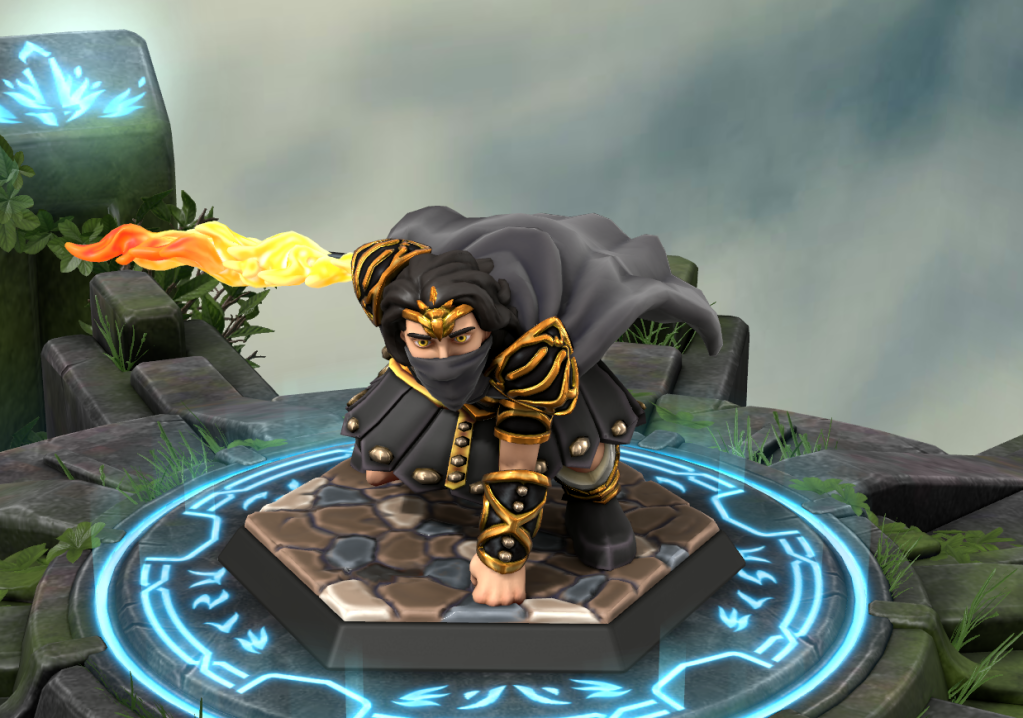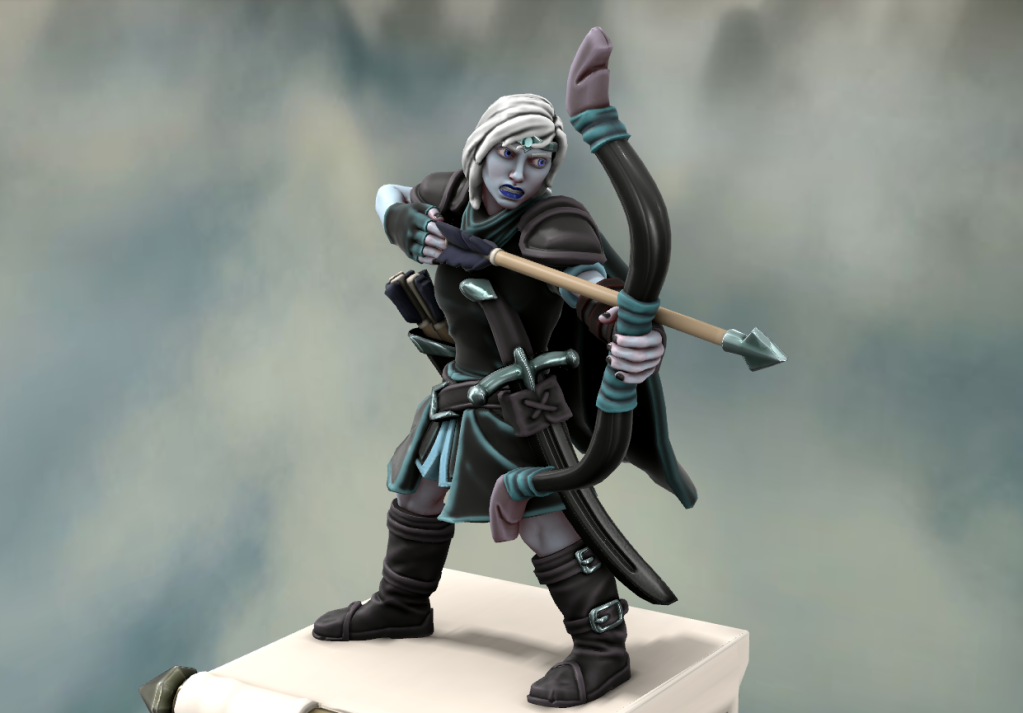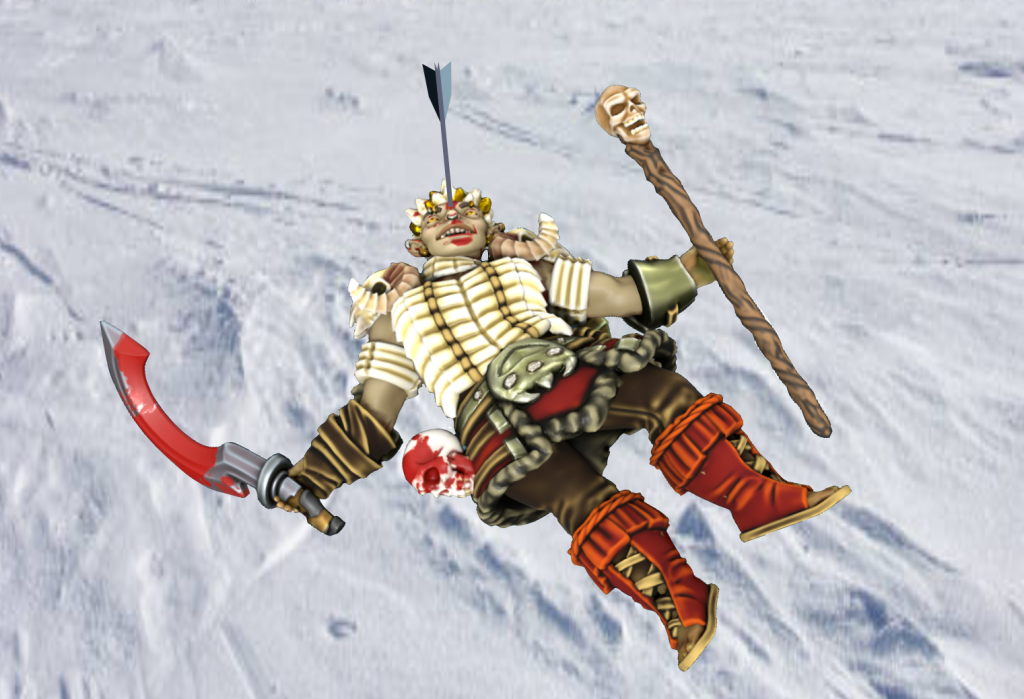The Legend of Gobb Kilrog the Bone Bearer is a multi-faceted epic tale from Rhûnnish folklore, and few times is the story told in its entirety. Instead, pieces of it serve as individual fables, and the lessons are sometimes questionable. The very beginning of the tale, for instance, is easily the most controversial part of it.
The legend doesn’t even begin with Kilrog himself, but with his parents, a lavkin father and a votrel mother. Their names vary depending on the region the tale is told in, and sometimes, parents would even change the names to match those of their own children to drive home the lesson. The lavkin fell madly in love with the votrel, who treated him with compassion, but felt no attraction to him, for while he was honourable, he was a dopey giant compared to her. She swooned when presented with the man she was to marry, however, but when the lavkin begged her not to marry him, she begged her father to delay the wedding and let her set things straight with her lavkin friend. She tried to explain that real love did not necessarily mean physical attraction, but he could not grasp the concept. How could she love him, but not wish to marry him? Three times the wedding was delayed, and each time the votrel spent more time comforting her lavkin friend, the two getting closer each time. Her family warned her that her compassion would betray her, that she should not try to comfort him so much, because he would not let go. The fourth time, she let him get too close, and he raped her. She was exiled by her own family for not heeding their warning, and gave birth alone in the forest to a hideously disfigured son. This child would come to be known as Gobb Kilrog. The moral of the story was originally that lavkins and votrels shouldn’t mix, but this societal ideal was quickly discarded during Alexandra’s Conquest, as lavkins and votrels regularly intermarried in Old Skhara, and the custom quickly became much more widely accepted in the Rhunnish lands. The moral of the story then shifted, instead focusing on being true and obedient to one’s family, and that compassion should be reserved only for those most worthy. As arranged marriages became less common, this part of the story dropped its moral entirely, and the first true fable was the second part of the story, with the moral being that a mother alone cannot raise a son.
Without a father to raise him, Gobb Kilrog was a rotten child who showed no interest in helping his mother gather food and maintain their hut in the forest. Instead, he spent most of his time tormenting animals, taking advantage of his enormous size and strength to tear them apart. Kilrog was extremely slovenly, but took great care in cleaning the bones of the animals he killed. He liked collecting bones, carving them, and building things out of them. As his mother grew old, and she no longer had the strength to go out into the woods and chop wood to fix the hut, she used the bones that Kilrog collected, and eventually, the hut was made entirely out of bones. The fence around the outside was made of leg bones and ribs and decorated with skulls, the lock was a set of sharp teeth, and for extra protection, the hut itself was perched on a pair of giant feet belonging to either a dragon or giant bird. To make Kilrog seem extra terrifying, sometimes the feet are said to be “like those of a giant eagle, but with five toes each,” which would indicate that they belonged to only one creature: the Night’s Dragon, but as you will see later, there is a continuity problem with this version of the tale. Usually, instead, the feet are simply said to be those of a giant chicken.
When Kilrog’s mother finally died, Kilrog decided to leave the forest. On the way out, he gathered followers who were entranced by all the trinkets that he adorned himself with, mostly made from bones, but there were a few precious stones and bits of gold as well. Kilrog had even fashioned a crown out of sharp bone fragments and gold pieces, and when asked what he was king of, he replied “I don’t know yet, my kingdom still awaits.” Gobb Kilrog’s followers grew quite numerous, and eventually started calling themselves “goblins.” Gobb Kilrog the Bone Bearer was henceforth known as the Goblin King.

The Goblin King was a personification of hedonism. He and all his goblins would take whatever they desired, either by deception or force, and spent much of their time indulging in material pleasures: gold, jewels, food, and drink. The rest of the time, they were either sleeping or stealing stuff. Goblins were not above stealing from each other, and this led to many goblins fighting amongst themselves. The Goblin King found this incredibly amusing, and even had a set of rules for goblins to fight by whenever they had a dispute. But with no limits on what sort of pleasures that the goblins could indulge in, real trouble started when goblins started stealing children. These children became slaves of the goblins, but after growing up exposed to nothing but hedonism, and seeing how goblins settled matters amongst themselves, those who grew up with the goblins ended up becoming goblins themselves. The moral of this part of the story is that a lifetime of hedonism will turn a person into a monster.
Many a village had children vanish without a trace, but goblins were not always sneaky enough. Sometimes they got caught, and when villagers realised that they had a goblin problem, they called for help and organised hunts for the goblins’ hideout. Many a bogatyr heroically led a charge of angry peasants who wanted their children back, and sometimes, the attack went very badly for them. Goblins love to collect bones, and skulls are among their most prized possessions. A goblin who steals another goblin’s trophy skull can expect his own skull to become a trophy in return. When they were attacked, the goblins fought back, and when they realised how much they enjoyed battle, they decided that they were going to stop sneaking, and start raiding. Thus the Goblin King went to war.
Many a bogatyr had tried and failed to bring down the Goblin King, including the legendary Bronze Bogatyr himself, leading to the final lines of the epic poem, Ballad of the Bronze Bogatyr. Upon learning that the Bronze Bogatyr fell in battle against the Goblin King, that the people he had sworn to protect had all been killed, and their children turned into goblins, the ice nymph Tiamarda the Huntress decided to kill Gobb Kilrog herself. In order to do this, however, she needed to get him out in the open, where she could shoot him in front of the goblins. The goblins moved through the mountains, usually hiding in caves, descending onto villages below when it was time to raid. In order to get the goblins out into the open for long enough, Tiamarda needed to force them to take a road of her choosing.

When the goblins began to march through the mountains, she started an avalanche that blocked off a mountain pass, forcing the goblins to march through a populated valley. When the goblins were busy killing everyone in the first village that they came to, Tiamarda would take the opportunity to shoot the Goblin King, but Solhanna appeared and drove off the goblins before Tiamarda could take the shot.

With the goblins driven off, and the villagers able to tend to their dead and wounded in peace, Tiamarda left, wondering if there was any reason to continue on this quest. After all, Solhanna’s reputation was widely known, and if she could protect villages from the goblins, there was no reason to hunt down the Goblin King. However, Tiamarda received some encouragement from an unexpected source: Chuyinka, a daemon bird seldom mentioned by name, if at all, in Rhûnnish folklore. In fact, this is the only Rhûnnish tale in which Chuyinka is portrayed as intelligent and eloquent. Chuyinka warned Tiamarda that the Goblin King would only continue to gain power if left alone, and that Solhanna would not be able to stop him forever. Tiamarda was curious about why Chuyinka would tell her any of this, and Chuyinka replied simply “don’t ask why the dark powers work against one another, just be glad they do.” This quote alone is particularly powerful message, and an adage of hope, intending to remind people that good triumphs over evil because the good work together, and the evil are self-serving.
The goblins marched through the forest toward the next village, where they were harried by dryads, the fairest of Leshy and Kikimora’s children, but Tiamarda, who knew that she was not welcome in those woods, simply passed through as quickly as she could, arriving in the next village before the goblins did. She found a place to shoot from, and waited for the Goblin King. Again the goblins slaughtered many in the village, but again Solhanna drove them off before Tiamarda could kill the Goblin King. Again the goblins marched through the woods, where they were again harried by dryads. This time, the other children of the forest, bitter rivals of the dryads, joined forces with the goblins, and brought along their pet wolves and bears, as well as other beasts that the dryads liked to hunt. The goblins and beasts arrived in another village, where Tiamarda was already waiting for them. She relished the opportunity to kill many fearsome beasts along with the Goblin King, but again, Solhanna appeared, driving off the goblins before Tiamarda could kill the Goblin King. Again the goblins marched through the woods, this time joined by Leshy and Kikimora themselves, before they came to the next village. Again, the goblins and beasts slaughtered many people, and again, many goblins and beasts were felled by Tiamarda’s arrows before Solhanna appeared. Ogres were unafraid of the silent warrior, despite the fact that none of them alone stood a chance against her. Together with their father, however, they proved to be too much for the warrior of light. Tiamarda had only one arrow left when she was faced with a terrible choice – to shoot Leshy, just as he was about to strike Solhanna down, giving her a chance to escape, or to shoot the Goblin King. Tiamarda chose to shoot Leshy, and she and Solhanna fled to the next village to await the Goblin King’s arrival. Kikimora was enraged at this, and spewed a litany of curses at Tiamarda, promising that all her children would forever hunt the ice-nymph.

Leshy 
Kikimora
When the Goblin King arrived, he had yet more fearsome beasts with him. This time, the beasts spread throughout the village so quickly, the Goblin King was out in the open right away.

Tiamarda put an arrow right between Kilrog’s eyes, thus fulfilling her quest.

The goblins scattered, but the ogres and beasts were still slaughtering the villagers. Tiamarda used up all her arrows before drawing her sword and fighting them up close, but she saw it as a futile endeavour, and decided to grab Solhanna and flee while they still had a chance.

Solhanna, however, was mute, but she wasn’t deaf. She had heard Kikimora’s litany of curses, and knew that wherever Tiamarda went, monsters would follow, but what if the monsters had to choose between avenging their father and avenging their mother? In order to draw some of the monsters away from both Tiamarda and the few villagers that still lived, Solhanna attacked Kikimora. Unlike Leshy, Kikimora was no match for the warrior of light, who cried out to Chuyinka to save her. Chuyinka had never once joined in on the slaughter, instead watching from a distance the whole time. Yet even now, Chuyinka refused to join in, and Kikimora cursed her child before she was struck down, damning the creature to a life forever in the darkness, and thus Chuyinka became known as the Night’s Dragon. The monsters then began attacking Solhanna, just as planned. She gestured for Tiamarda to flee if she wished, but indicated that she was staying behind. As Tiamarda walked away from the ruined village, a massive burst of light radiated out from where Solhanna had stood. Beasts and ogres ran out of the ruined village in all directions, most of them clearly blinded. Tiamarda walked through the silent remains of the village, and there was no sign of Solhanna. She had simply vanished, as she always did. “I’ll see you again, won’t I?” Tiamarda whispered as she walked out of the village, toward the next one in the valley. On her way to the next village, Tiamarda rescued a hunter who had slipped on some ice and become pinned underneath the stag he was trying to bring home. She told him her story, and the hunter told his family when he finally reached home, which was on the outskirts of a village called High Springs.
High Springs was the birthplace of the Faith in the Crystals, and the entire story about the rise and fall of the Gobb Kilrog is a metaphor for the transformation of religious beliefs throughout the Rhûnnish lands. Leshy and Kikimora both died, as did most of their children, and the remaining supernatural creatures were ever all at odds with each other afterward. Both Tiamarda and Solhanna feared that lingering too long at any village would doom said village to destruction by the Leshënki (children of the forest). As they were rarely seen again, the Rhûnnish people moved away from worshipping nature and animalistic spirits to worshipping immaterial spirits that channelled their power through crystals. Fifteen centuries later, the sacred site was renamed Fell Springs when Alexandra Skharnova seized control of the town and built a massive fortress on top of it, from whence she would begin her conquest of the Rhûnnish lands. Oddly enough, the old lore enjoyed a bit of a revival during the imperial period, since the religion of Old Skhara was much more similar to the ancient traditions of nymph worship than to the Faith in the Crystals, but the latter was still propped up by the Skharnov Dynasty as a way of holding on to power. After all, it was by stripping the petty tsars of their sacred crystals and building a throne out of them that Alexandra Skharnova cemented her dominion over the Rhûnnish lands in the first place. Furthermore, it was during the imperial period that many of these tales were finally written down for the first time, and compiled into long epic stories and poems, rather than the short tales and songs that had been passed down via oral traditions through the ages.